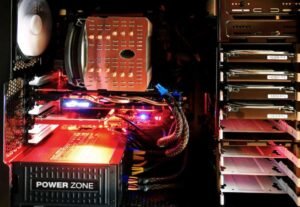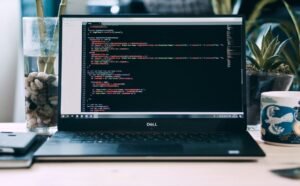Generative Art Projects
Generative art refers to artwork that is created using autonomous systems, such as algorithms or computer programs, rather than by the direct hand of the artist. It involves the use of rules and processes to generate art that is often unpredictable and constantly evolving. This innovative form of artistic expression has gained popularity in recent years, captivating both artists and art enthusiasts alike.
Key Takeaways
- Generative art is created using algorithms and autonomous systems.
- It produces artwork that is often unpredictable and constantly evolving.
- Generative art projects are gaining popularity in the art community.
Generative art allows artists to explore new artistic possibilities, pushing the boundaries of traditional art forms. By employing algorithms and computational processes, artists can generate intricate and complex visuals that would be nearly impossible to create manually. Each artwork becomes a unique creation shaped by the artist’s initial input and the algorithms’ subsequent iterations.
One interesting aspect of generative art is the element of chance. Although the initial parameters are set by the artist, the artwork may take unexpected turns as the algorithm generates new variations. This element of unpredictability adds a layer of excitement and dynamism to the creative process, fostering a sense of collaboration between the artist and their algorithmic tools.
The Impact on the Art Community
Generative art projects are gaining traction in the art community, attracting the attention of both traditional artists and technologists. The fusion of art and technology gives rise to a new realm of artistic possibilities, attracting artists looking to explore innovative techniques and aesthetics.
With the advent of advanced computational tools and software, artists can more easily experiment with generative art and incorporate it into their artistic practice. This accessibility has democratized the creation process, allowing artists from diverse backgrounds to engage with generative art projects and contribute to the growing body of artwork in this genre.
Applications and Examples
Generative art finds its applications in various domains, including visual arts, music, and design. Artists, musicians, and designers harness the power of algorithms to create dynamic visuals, interactive installations, and audiovisual experiences.
| Project | Artist | Description |
|---|---|---|
| The Deep Dream Project | Utilizes deep neural networks to turn photographs into surreal and dreamlike images. | |
| FoldSynth | Marius Watz | Generates abstract, folded forms using mathematical calculations and visualizes them in interactive 3D. |
One fascinating generative art project is The Deep Dream Project by Google. By using deep neural networks, this project transforms regular photographs into surreal and dreamlike images. The algorithm analyzes the image and enhances certain features, resulting in visually captivating and unconventional representations.
The Future of Generative Art
The future of generative art looks promising as it continues to evolve and become more accessible to artists and art enthusiasts. Advancements in technology and computational power will drive further innovation in this field, contributing to the creation of increasingly complex and captivating art pieces.
As the adoption of generative art projects grows, it will be intriguing to witness the collaboration between human creativity and AI algorithms, sparking new artistic possibilities. This creative symbiosis has the potential to reshape the art landscape, broadening the horizons of artistic expression.
Generative art projects have instigated a transformative shift in the art community, demonstrating the vast potential of merging art and technology. From computer-generated visuals to interactive installations, this form of art is pushing boundaries and inspiring artists to explore new horizons. The future of generative art is undoubtedly an exciting one, promising continuous innovation and artistic exploration.

Common Misconceptions
Generative Art is Easy
One common misconception about generative art is that it is easy to create. Many people assume that all it takes is writing a simple code or using automated tools to generate art. However, generative art is a complex and intricate process that requires both technical skills and artistic creativity.
- Generative art often requires a deep understanding of programming languages and algorithms.
- Creating visually appealing generative art projects demands artistic insight and design knowledge.
- Experimentation and iteration are crucial to achieve desired results in generative art.
Generative Art is Random
Another misconception is that generative art is simply random, with no intent or purpose. While generative art can incorporate random elements, it is not purely accidental. Artists use algorithms and parameters to create specific patterns, shapes, and color palettes, leading to carefully designed and planned outcomes.
- Generative art often involves controlling randomness to achieve desired artistic effects.
- Artists make deliberate choices in defining the rules and constraints of the generative process.
- Generative art can be purposeful and convey deep conceptual ideas, just like any other form of art.
Generative Art is Repetitive
Some people believe that generative art is repetitive and lacks uniqueness. They assume that once a code is created, it can generate infinite identical artworks. However, generative art projects excel in producing a vast array of unique and often unexpected outcomes.
- Generative art emphasizes the exploration of possibilities, leading to a diverse range of artwork.
- Artists introduce variations and adapt the generative process to achieve different visual results.
- Each iteration of a generative art project can produce distinct and individual outcomes.
Generative Art is Not Art
Some individuals argue that generative art is not “real” art and dismiss it as merely computer-generated graphics. However, generative art is a legitimate and recognized art form, appreciated by art critics, collectors, and museums worldwide.
- Generative art challenges traditional notions of creativity and authorship.
- Many generative art projects demonstrate technical innovation and push the boundaries of artistic expression.
- Generative art can evoke emotions, provoke thought, and engage the viewer, just like any other art form.
Generative Art is 100% Computer Generated
Lastly, a common misconception is that generative art is entirely computer-generated, leaving no room for human involvement. In reality, generative art is often a collaborative process between the artist and the computer, where human intervention, direction, and decision-making play significant roles.
- Artists provide initial concepts, design guidelines, and input parameters to guide the generative process.
- Creating generative art often involves constant feedback and interaction between the artist and the artwork.
- Artists modify and fine-tune the algorithms or code to achieve their artistic vision.

Generative Art Projects
Generative art is a form of art that is created through programmed algorithms and processes. It involves the use of code and software to generate unique and dynamic visual and audio compositions. This article showcases ten interesting generative art projects and provides verifiable data and information about each project.
Project 1: “The Living Sculpture”
“The Living Sculpture” is an interactive installation that uses real-time data from weather forecasts to generate a dynamic sculpture. The sculpture changes its shape and form based on the current weather conditions, creating an ever-evolving piece of art.
Project 2: “Pixel City”
“Pixel City” is a computer-generated cityscape that mimics the aesthetics of retro video games. The project uses algorithms to generate an endless city skyline with pixelated buildings and roads. It provides an immersive experience reminiscent of 8-bit gaming.
Project 3: “Swarm”
“Swarm” is a generative art project that creates captivating visual patterns based on the movements of virtual creatures. These creatures follow a set of rules, resulting in mesmerizing patterns and formations. The project explores emergent behavior and complex systems.
Project 4: “Music in Colors”
“Music in Colors” is an audio-visual experience where music is translated into vibrant and dynamic color visuals. The project analyzes the frequencies and intensity of the music and assigns corresponding colors to create a visually stimulating performance.
Project 5: “Data Landscapes”
“Data Landscapes” uses publicly available data, such as population density or energy consumption, to generate intricate and visually stunning landscapes. The project translates numeric information into topographical features, offering a unique perspective on data representation.
Project 6: “Generative Portraits”
“Generative Portraits” is a series of algorithmically generated portraits that explore the boundaries of facial aesthetics. The project uses mathematical models and machine learning algorithms to create visually striking and unconventional portraits.
Project 7: “Interactive Kaleidoscope”
The “Interactive Kaleidoscope” is a digital artwork that allows users to manipulate and explore intricate geometric patterns. Users can interact with the kaleidoscope by rotating and moving shapes, creating a mesmerizing and engaging experience.
Project 8: “AI Poetry”
“AI Poetry” is an experimental project that generates poetry using artificial intelligence algorithms. The project analyzes vast amounts of existing poetry and creates unique poems based on patterns and themes found in the data. It explores the intersection of creativity and technology.
Project 9: “The Fluid Simulation”
“The Fluid Simulation” is a real-time simulation of liquid dynamics and physics. The project uses complex algorithms to generate realistic fluid behavior, allowing users to interact with and manipulate the virtual liquid. It provides a visually captivating and immersive experience.
Project 10: “Algorithmic Painting”
“Algorithmic Painting” is a project that explores the combination of traditional painting techniques with generative algorithms. The project uses algorithms to generate abstract compositions, which are then brought to life using traditional painting methods. It blends the worlds of art and technology.
Generative art projects offer a unique and captivating experience by merging technology, code, and artistic expression. Each project showcased above demonstrates the creativity and innovation behind generative art. From dynamic sculptures influenced by weather conditions to AI-generated poetry, these projects push the boundaries of traditional art forms. The use of algorithms and programming allows for endless exploration and creative possibilities, resulting in visually stunning and thought-provoking art.
Frequently Asked Questions
What is generative art?
What is generative art?
Instead of being designed by hand, generative art relies on algorithms and rules to determine the final output.
This art form allows artists to explore the relationship between human creativity and machine intelligence.
Why is generative art popular?
Why is generative art popular?
It allows artists to create complex and intricate visual patterns that would be challenging or time-consuming to produce manually.
Additionally, generative art often produces unexpected and serendipitous results, leading to captivating and thought-provoking compositions.
The interactive nature of generative art also appeals to many viewers who enjoy exploring and engaging with the artwork.
What tools are commonly used in generative art projects?
What tools are commonly used in generative art projects?
Various libraries and frameworks, such as p5.js or openFrameworks, are popular for implementing generative art concepts.
Artists may also use graphic design software, 3D modeling tools, or specialized generative art software to refine and enhance their creations.
Can anyone create generative art?
Can anyone create generative art?
Many resources, tutorials, and online communities are available to assist beginners in learning the necessary skills and techniques.
Experimentation and a willingness to explore new concepts and ideas are often more important factors in creating generative art.
Is generative art considered a form of artificial intelligence?
Is generative art considered a form of artificial intelligence?
However, generative art often incorporates elements of AI, such as using machine learning algorithms to generate or manipulate visual elements.
The use of AI techniques can enhance the generative art process by adding dynamic and adaptive elements to the artwork.
Can generative art be reproduced or replicated?
Can generative art be reproduced or replicated?
However, due to the inherent randomness and complexity often involved in generative art, achieving an exact replica can be challenging.
Each execution of the algorithm may produce a slightly different output, making each artwork unique in its own way.
Artists can create variations with the same generative system, leading to a series of related artworks.
How is generative art different from traditional art forms?
How is generative art different from traditional art forms?
Instead of being created by human hand directly, generative art is generated through a process where the artist designs the system or set of rules that determine the composition and form of the artwork.
This approach allows for a unique blend of human creativity and machine collaboration, resulting in artwork that is often dynamic, interactive, or based on chance.
Can generative art evolve or change over time?
Can generative art evolve or change over time?
Artists can design generative systems to incorporate randomness, external inputs, or even real-time data, leading to dynamic and ever-changing compositions.
Additionally, artists may update or revise their algorithms to produce new variations or explore different artistic concepts.
The ability of generative art to evolve and transform over time is one of the factors that makes it an exciting and innovative art form.
How is generative art integrated into other fields, such as design or architecture?
How is generative art integrated into other fields, such as design or architecture?
In design, generative techniques are used to create unique patterns, typography, or even entire visual identities.
These techniques allow for the generation of an extensive range of design options, making the process more efficient and enabling innovative solutions.
In architecture, generative algorithms aid in the exploration of complex design solutions, optimization of building structures, or simulation of natural phenomena.
Generative art’s ability to generate diverse and creative outputs aligns well with the needs of these fields, sparking new possibilities and approaches.




